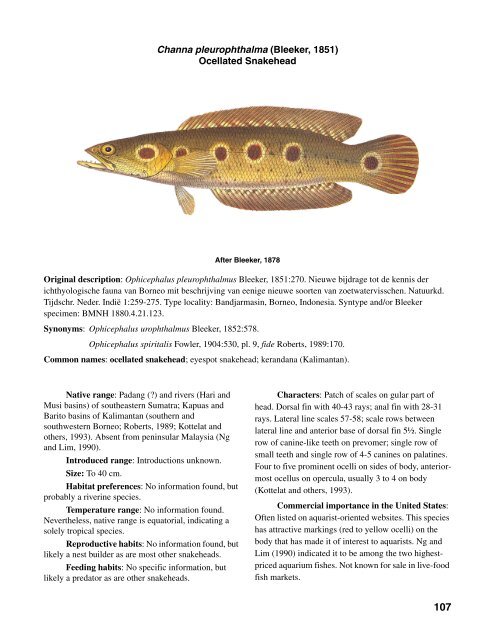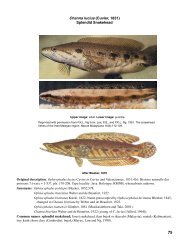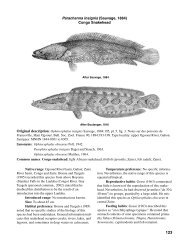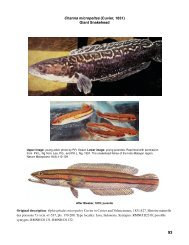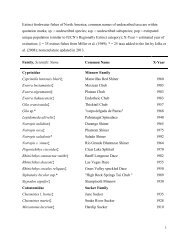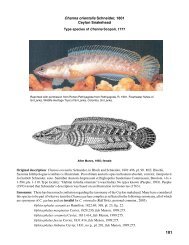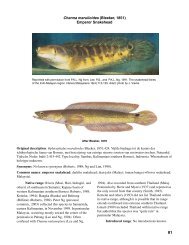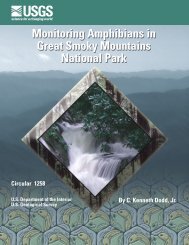Channa pleurophthalma (Bleeker, 1851) Ocellated Snakehead
Channa pleurophthalma (Bleeker, 1851) Ocellated Snakehead
Channa pleurophthalma (Bleeker, 1851) Ocellated Snakehead
- No tags were found...
You also want an ePaper? Increase the reach of your titles
YUMPU automatically turns print PDFs into web optimized ePapers that Google loves.
<strong>Channa</strong> <strong>pleurophthalma</strong> (<strong>Bleeker</strong>, <strong>1851</strong>)<strong>Ocellated</strong> <strong>Snakehead</strong>After <strong>Bleeker</strong>, 1878Original description: Ophicephalus pleurophthalmus <strong>Bleeker</strong>, <strong>1851</strong>:270. Nieuwe bijdrage tot de kennis derichthyologische fauna van Borneo mit beschrijving van eenige nieuwe soorten van zoetwatervisschen. Natuurkd.Tijdschr. Neder. Indië 1:259-275. Type locality: Bandjarmasin, Borneo, Indonesia. Syntype and/or <strong>Bleeker</strong>specimen: BMNH 1880.4.21.123.Synonyms: Ophicephalus urophthalmus <strong>Bleeker</strong>, 1852:578.Ophicephalus spiritalis Fowler, 1904:530, pl. 9, fide Roberts, 1989:170.Common names: ocellated snakehead; eyespot snakehead; kerandana (Kalimantan).Native range: Padang (?) and rivers (Hari andMusi basins) of southeastern Sumatra; Kapuas andBarito basins of Kalimantan (southern andsouthwestern Borneo; Roberts, 1989; Kottelat andothers, 1993). Absent from peninsular Malaysia (Ngand Lim, 1990).Introduced range: Introductions unknown.Size: To 40 cm.Habitat preferences: No information found, butprobably a riverine species.Temperature range: No information found.Nevertheless, native range is equatorial, indicating asolely tropical species.Reproductive habits: No information found, butlikely a nest builder as are most other snakeheads.Feeding habits: No specific information, butlikely a predator as are other snakeheads.Characters: Patch of scales on gular part ofhead. Dorsal fin with 40-43 rays; anal fin with 28-31rays. Lateral line scales 57-58; scale rows betweenlateral line and anterior base of dorsal fin 5½. Singlerow of canine-like teeth on prevomer; single row ofsmall teeth and single row of 4-5 canines on palatines.Four to five prominent ocelli on sides of body, anteriormostocellus on opercula, usually 3 to 4 on body(Kottelat and others, 1993).Commercial importance in the United States:Often listed on aquarist-oriented websites. This specieshas attractive markings (red to yellow ocelli) on thebody that has made it of interest to aquarists. Ng andLim (1990) indicated it to be among the two highestpricedaquarium fishes. Not known for sale in live-foodfish markets.107
Commercial importance in native range:Kottelat and others (1993) indicated <strong>Channa</strong><strong>pleurophthalma</strong> as an important food fish in Indonesiaand Sumatra. Lee and Ng (1991) noted that it is sold inmarkets of Sumatra and Kalimantan. Dudley (2000)reported it in the fishery of Danau Sentarum WildlifeReserve, Kapuas River, Kalimantan.Environmental concerns: Ng and Lim (1990)stated that the aquarium fish trade is growing inIndonesia and Malaysia, indicating that this species,among others, may have become more readily availablefor sale in the U.S. Like other snakeheads, this speciesis probably a thrust predator. Nevertheless, it is anequatorial species that could probably survive in veryfew waters (thermal springs, perhaps extreme southernpeninsular Florida, and Hawaii) if introduced intothe U.S.100° E120°E140°EChinaEXPLANATIONDISTRIBUTION OF<strong>Channa</strong> pleuropthalmaNative range20°N0°MyanmarPACIFICOCEANThailand LaosPhilippinesVietnamCambodiaMalaysiaMalaysiaINDIANOCEANIndonesia Equator0 500 MILES0 500 KILOMETERSScale is approximateIndonesia<strong>Channa</strong> <strong>pleurophthalma</strong>Indonesia108
<strong>Channa</strong> punctata (Bloch, 1793)Spotted <strong>Snakehead</strong>After Bloch, 1793; images reversed from original pl. 358After Munro, 1955After <strong>Bleeker</strong>, 1878Original description: Ophicephalus punctatus Bloch, 1793:139, pl. 358. Naturgeschichte der AusländischenFische, 7:i-xiv + 1-144, pls. 325-360. Type locality: rivers and lakes of Malabar coast, southwestern India. Syntype:ZMB 1394.Synonyms: Ophicephalus karruwey Lacepède, 1801:551-552.Ophicephalus lata Hamilton, 1822:63.Ophicephalus indicus McClelland, 1842:583.Ophiocephalus affinis Günther, 1861:470.Common names: spotted snakehead; green snakehead; dolla or daula (Pakistan); taki, lata (West Bengal, India);phool-dhok (Bihar, India); duloora, daula (Punjab, India); soal (Jammu, India); gorissa or godissa (Orissa, India);matta-gudisa, burada-matta (Andhra Pradesh, India); korava-patti (Tamil Nadu, India); kayichal, arracan (Kerala,India); korava, juchi, belikkorava (Karnataka, India); (Talwar and Jhingran, 1992); cheng (northern Bengal, India;Shaw and Shebbeare, 1938); mada kanaya (Sri Lanka; Pethiyagoda, 1991).109
(Chacko and Kuriyan, 1947), is about 22-23 cm indiameter. Breeding typically occurs at night, and takesplace twice each year (Raj, 1916). Kahn (1924) statedthat this species builds elaborate tunnels to the nestthrough surrounding vegetation. Jhingran (1984) indicatedthat reproduction in ponds occurs through mostof the year. The larger the parents, the more offspringthey produce. Fecundity is between 2,300 to 29,600eggs, with egg diameter peaking at slightly less than0.5 mm. This information is in contrast to thatpresented by Kahn (1924) who recorded egg size as2 mm. Khan (1924) also stated that hatching occurredin 54 hrs at 16-26 ºC and 30 hrs at 28-33 ºC. Protectionof young continues for 15-20 days until juvenilesbecome demersal (Quayyum and Qasim, 1962).Spawning in southern Nepal occurs from June untilAugust (Shrestha, 1990). Lowe-McConnell (1987)gave April to July as the spawning period in PunjabProvince, India, citing brood size as up to 500 individuals;guarding occurs for up to a month or until youngare 10 cm long. Reddy (1979) stated that spawningoccurs once per pair during July to October, with maximalspawning between July and August in AndhraPradesh Province, southeastern India. This agrees withBhuiyan and Rahman (1984) who reported a singleannual spawning between April and August in Bangladesh.It appears that spawning season is largely correlatedto active monsoonal periods. This is one of threespecies known to spawn in ponds lacking vascularaquatic plants (Parameswaran and Murugesan, 1976b).Joshi and Sathyanesan (1981) reported findingstage I oöcytes in testicular tissue of 2 of over 100specimens of <strong>Channa</strong> punctata, all collected in Decemberwhen the species is reproductively inactive.Oöcytes were scattered through the testis and thegonads appeared to be a normal testis externally.Feeding habits: Young (1.5-3.0 cm) feed primarilyon zooplankton, with rotifers, insect, and crustaceanlarvae constituting most of the diet. Adultsconsume fishes, insects, and aquatic vegetation(Quayyum and Qasim, 1962), the latter probablyingested in the process of capturing animal prey.The species is an opportunistic feeder. In canalsand irrigation ponds near Guntur, Andra Pradesh State,India, stomach contents consisted of 13 species ofsmall fishes with young of <strong>Channa</strong> punctata (one each)found in only three individuals, indicating that cannibalismis rare. Fish bones, scales, fin rays, etc., werecommon. Insects comprised the second tier of ingestedfood, followed by crustaceans, tadpoles, and an annelidworm. No algae were found, but parts of leaves andseeds were occasionally observed. By far, the mostcommon food item was fishes (Reddy, 1980). Incontrast, in polluted Hussainsagar Lake, Hyderabad,Andra Pradesh State, insects and their larvae werepreferred (59.5 percent), followed by fishes and fishlarvae (12.5 percent), annelids, algae, leaves, crustaceans,amphibians, and gastropods (Reddy and Rao,1990). In ponds, tanks, and canals in the central deltaarea of River Godavari, Andra Pradesh, only 24 percentof the diet consisted of fishes, but 41.6 percent werecrustaceans. Dutta (1994) found insects dominant (upto 100 percent) in young (3.1-4.5 cm in length)followed by crustaceans (up to 25 percent) and fishes,except for the months of June, July, and Novemberwhen no fishes were found. All individuals above alength of 5 cm contained fishes. This study wasconducted on specimens captured from GadigarhStream, Jammu, northern India.Wee (1982) cited a study by Panday and Dwivedi(1974) in which it was shown that <strong>Channa</strong> punctata haswell-developed olfactory organs in the nasal sacs andtaste buds extending into the esophagus, concludingthat this species locates food by odor. He also citedGerald (1976b) as reporting maximal feeding activityof this species occurs at 28 ºC. Food absorption efficiencywas reported as 95.5 percent (Gerald, 1976a).Larger fish have a lower feeding rate than young(Gerald, 1976a).Characters: Body elongated, mostly rounded; 4or 5 scales between orbit and angle of preopercle, 12 or13 predorsal scales; pelvic fins more than half thelength of pectoral fins, extending to anal fin; pectoralfins plain, no vertical bands, 15-16 rays, about 75percent of pectoral fin length; anal fin rays 28-37;dorsal fin rays 28-32, rarely 33; caudal fin rounded.Mouth large; lower jaw with 3 to 6 canines behind asingle row of villiform teeth that widen to 5 or 6 rowsat jaw symphysis. Predorsal scales 12; scales in lateralseries 37-40; scales on top of head large, arranged in arosette between orbits, the frontal scale of which has anopen lateralis pit, forming the center of the rosette(Talwar and Jhingran, 1992; Jayaram, 1999). Lifecolors vary from black to pale green on dorsum andsides, ventral sides white to pale yellow, sometimeswith red tinge; several dark blotches on lower sides;occasionally black spots on body and dorsal, anal, andcaudal fins. Dorsal, anal, and caudal fins dark gray,sometimes with reddish edge; pectoral and pelvic finspale orange (Talwar and Jhingran, 1992).111
Commercial importance in the United States:Although occasionally listed on aquarist-orientedwebsites and in aquarium fish books, this species doesnot appear to have been important to the aquarium fishtrade in North America. It is not known to have beenimported for culture or live-food fish market sale.Commercial importance in native range:<strong>Snakehead</strong> fishes in general are regarded as importantfishery resources in India and elsewhere, fishedcommercially and some species utilized in aquaculture.Quayyum and Qasim (1962) reported this species as"the main bulk of pond fishery in the plains of northernIndia." Rao and Durve (1989) reported <strong>Channa</strong> punctataas one of three snakehead species fished commerciallyin Lake Jaisamand, the oldest reservoir in India.They are considered to be a delicacy and demand highprices (Talwar and Jhingran, 1992). Pethiyagoda(1991) noted that it is popular as a food fish in SriLanka and is also used as bait for catching larger snakeheads.Environmental concerns: Because of theirvoracious, carnivorous feeding habits, snakeheads areregarded as pests in India due to their devastation ofother fishes (Talwar and Jhingran, 1992), apparently inpond or culture situations where other desired speciesexist.Comments: Banerjee and others (1988)recorded the diploid chromosome number of <strong>Channa</strong>punctata as 32. Dhar and Chatterjee (1984), however,found two groups, one with 32 and another with 34,indicating a species complex.40°N60° E80° E100°E120°ENorthKoreaIranAfghanistanPakistanNepalBhutanChinaSouthKorea20°NSaudiArabiaIndiaMyanmarBangladeshThailandLaosVietnamThailandMalaysiaCambodia0°EquatorINDIAN OCEANIndonesiaEXPLANATIONDISTRIBUTION OF<strong>Channa</strong> punctataNative range0 1,000 MILES01,000 KILOMETERSScale is approximate<strong>Channa</strong> punctata112
<strong>Channa</strong> stewartii (Playfair, 1867)Golden <strong>Snakehead</strong>After Playfair, 1867Original description: Ophiocephalus stewartii Playfair, 1867:14, pl. 3. On the fishes of Cachar. Proc. Zool. Soc.Lond. 1867(1):14-17, pl. 3. Type locality: Cachar, Assam, India. Syntypes: BMNH 1867.2.14.19-20.Synonyms: None known.Common names: golden snakehead; Assamese snakehead; sengalee (Assam, India; Talwar and Jhingran, 1992);helae (Nepal).Native range: Endemic to Brahmaputra (upper,middle, lower) River basin of India and Bangladesh,and the Ganges River basin from southern Nepalsoutheastward (Sen, 1985; Talwar and Jhingran, 1992;Musikasinthorn, 2000). In southern Nepal, it occurs inthe Kamala, Bagmati, Koshi, Gandaki, and KarnaliRiver basins (Shrestha, 1990).Introduced range: Introductions unknown.Size: To 25.4 cm (Sen, 1985).Habitat preference: Flowing and standing water(Talwar and Jhingran, 1992); marshes and estuaries,and tolerant of limited salinity (Sen, 1985). Sen andDey (1984) recorded this species from altitudes above1,500 m in Meghalaya, a plateau north of Bangladeshand south of the Brahmaputra River, India.Temperature range: No specific information.Native range is about 22-27º N, indicating a warmtemperate to subtropical species.Reproductive habits: No specific information,but probably a nest builder providing eggs and youngwith parental care.Feeding habits: No specific information, butlikely a thrust predator like other snakeheads.Characters: No patch of scales on gular regionof head. Dorsal fin with 39-40 rays; anal fin rays 27.Pelvic fin about one-third as long as pectoral. Lateralline scales 47-50; scale rows between preopercularangle and posterior border of orbit 4-5; predorsal scales13. Dorsal fin originates above base of pectoral fin.Black spots on many body scales.Commercial importance in the United States:Rarely mentioned in aquarist-oriented websites butavailable through aquarium fish trade. Not known to beavailable in live-food fish markets.Commercial importance in native range:Talwar and Jhingran (1992) stated that this species is ofonly minor fishery interest.Environmental concerns: Likely a thrust predator,feeding on other fishes and invertebrates.Comments: The diploid chromosome number of<strong>Channa</strong> stewartii is 104 (Rishi and Haobam, 1984).113
80° E100°ENepalBhutanChinaEXPLANATIONDISTRIBUTION OF<strong>Channa</strong> stewartiiNative range20°N0 1,000 MILESIndiaBangladeshBay ofBengalMyanmarLaosThailand01,000 KILOMETERSScale is approximateThailandVietnamCambodiaMalaysia0°EquatorIndonesia<strong>Channa</strong> stewartii114


